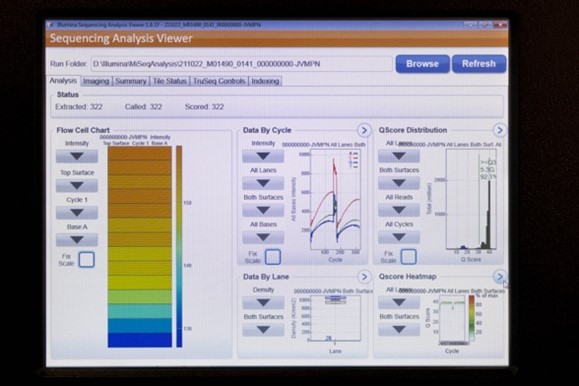Translational Genomics
Genetic Analysis Service
We perform the genetic study of organisms based on various technical approximations:
a) Deep Sequencing (NGS)
NGS involves the preparation of libraries and the subsequent high-throughput sequencing of the target genomic region. Being able to perform many readings allows the detection of rare clonal types, cells or microorganisms, which account for only 1% of the original sample, etc. Libraries are prepared using various approximations with the purpose of obtaining fragments with the right size, to which bar codes (identifiers for each sample) and the necessary adapters for being read have been added.
Applications. This technology may be applied to: a) genomic DNA (whole genome), b) DNA-enriched fragments, c) whole simple genomes (small genomes), d) metagenomic profiles (16S, ITs or others), e) RNA (transcriptomics, RNA profiling), f) small RNAs/miRNAs, g) immunoprecipitated chromatin (Chip-Seq), h) exome studies, etc.
Sequencing is performed with two MiSeq® personal sequencers (Illumina), a NextSeq-1000 system (Illumina) and a MinION sequencer (Oxford Nanopore).
b) Capillary electrophoresis for sequencing
This is the gold standard technique for genetic diagnosis when analysing target regions within the genome. These techniques allow both Sanger-based sequencing and analysis of gene fragments (genescan).
The most common applications are: de novo DNA sequencing; detection/confirmation of mutations; allelic discrimination studies (SNPs); analysis of gene methylation patterns in CpG islands of genomic DNA (MSP); analysis of gene copy number variations (CNVs); analysis of microsatellites (STRs, VNTRs); ligation-mediated PCR and multiplex ligation-dependent probe amplification (MLPA).
These techniques are performed using the genetic analysers ABI 3130 and ABI 3130xl (Applied Biosystems).
c) Capillary electrophoresis for analysing nucleic acid quality
We have a bioanalyzer 2200 TapeStation (Agilent) to assess the quality of nucleic acids. This bioanalyzer is an automated system for the qualitative and quantitative analysis of nucleic acids by capillary electrophoresis.
The applications provided are: qualitative/quantitative analysis of gDNA (including a calculation for DNA integrity [DIN]), DNA fragments (around 150-5000 bp) and RNA in standard format and high sensitivity (including a calculation for RNA integrity (RIN).
d) Amplification of nucleic acids
- Real time PCR, based on monitoring of emitted fluorescence during the amplification reaction at each cycle for all samples simultaneously. Real time PCR allows to determine the amount of DNA, RNA or miRNA in the original sample (qPCR) or to perform a qualitative profiling of specific DNA samples (genotyping).
The main applications are: absolute/relative quantification of gene differential expression profiles; allelic discrimination studies (SNPs); analysis of gene methylation patterns in CpG islands; analysis of gene copy number variations (CNVs) for genomic or viral DNA; quantification of gene dose (QFPCR for the detection of aneuploidies); high resolution melting (HRM) for gene scanning.
- Digital PCR (dPCR) Digital PCR is a technology that fragments each sample in more than 20,000 individual drops where the polymerase chain reaction occurs. It can be performed using double-stranded intercalating agents or probes with fluorescent labels, and provides absolute and ultrasensitive quantification of nucleic acids. Digital PCR is particularly useful to quantify low abundant gene fragments, allelic variants (SNPs), viruses and bacteria with a low representation in a heterogeneous mixture, etc.
Auxiliary services
- Fluorimetric quantification using Quantus™ fluorometer (Promega), a fluorimeter with two channels optimized for measuring nucleic acids (RNA and DNA) before and after the generation of NGS libraries.
- Robot-controlled dispensing of liquids using the EpMotion 5070 station (Eppendorf). It can perform serial dilutions and PCR assays, can transfer samples from tubes to a plate (96-well and 384- well plates), can reconfigure plates, etc.
It can also provide guidance for experimental design, sample preparation, analysis of results and overall data interpretation.




